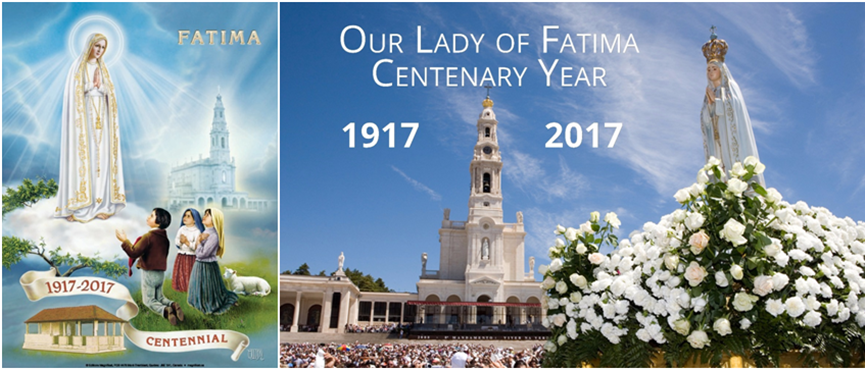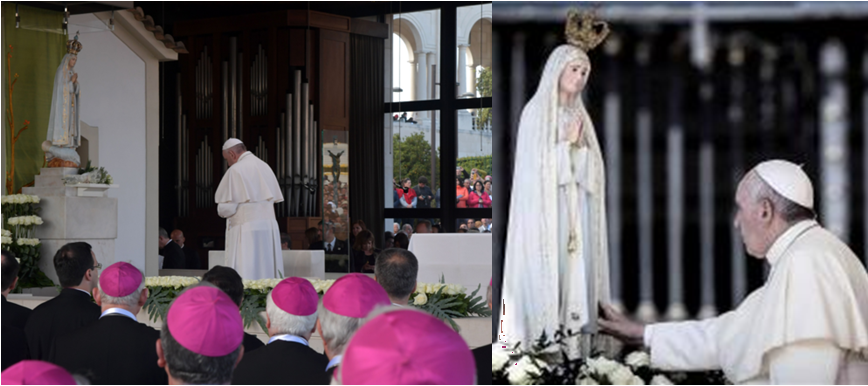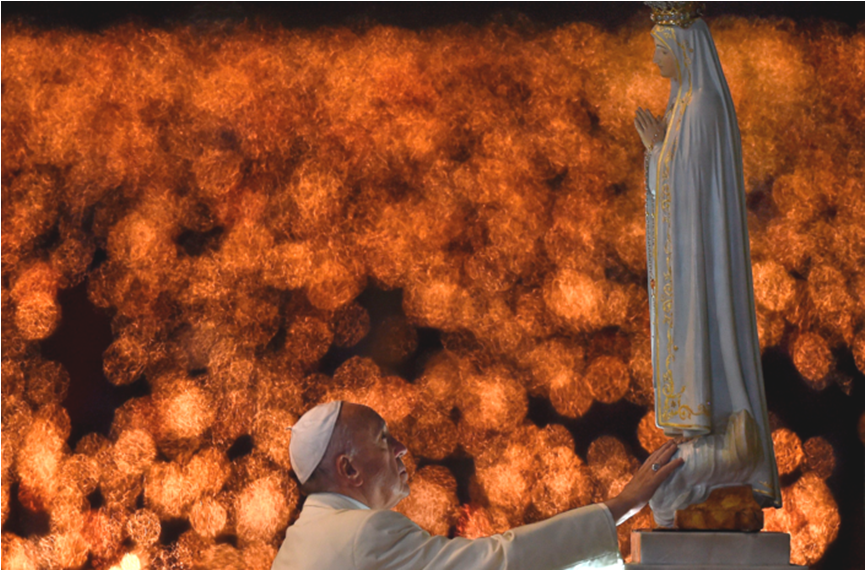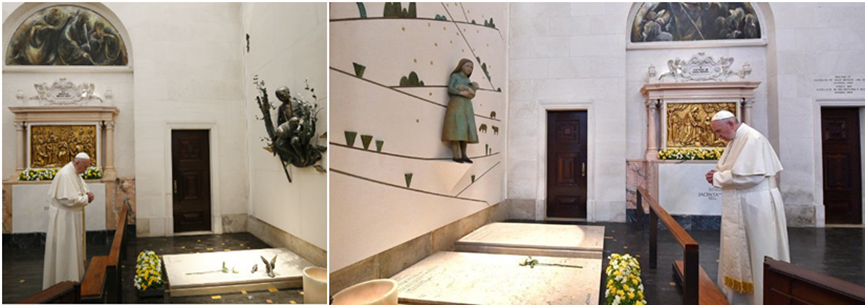| | | OFFLINE | | Post: 31.097
Post: 13.187 | Registrato il: 28/08/2005
Registrato il: 20/01/2009 | Administratore | Utente Gold | |
|
 Riccardo Cascioli not surprisingly echoes Antonio Socci's commentary on Jorge Bergoglio's outrageous destruction-by-personal-exegesis
Riccardo Cascioli not surprisingly echoes Antonio Socci's commentary on Jorge Bergoglio's outrageous destruction-by-personal-exegesis
of the message of Fatima...
Question for Pope Francis:
Which Mary do you invoke in your personal
interpretation of the message of Fatima?
By Riccardo Cascioli
Translated from

14-05-2017
“Which Mary?” Pope Francis asked Friday evening in his address before the blessign of the candles at the Chapel of the Apparitions in Fatima.
“Which Mary?”, he asked, only to give an answer which – as often happens – only serves to divide Catholics into the good (few) and the bad (the overwhelming majority).
But so many Catholics would have asked ‘Which Mary?”, and especially “Which Lady of Fatima?”, after this pope’s personal itnerpretation of the events which took place in Cova da Iria, Fatima, 100 years ago.
Because in the pope’s address, there was no trace of any call for conversion, for penitence, for sacrifice for the reparation of sins, of the vision of Hell, of the historical consequences in our time of mankind (wars continue and Communism has not stopped to propagate its nefarious consequences, even within the Church herself).
The problem we have with the pope’s address is not primarily his interpretation but facts. Like it or not:
- The three shepherd children were shown a horrible vision of Hell.
- Francisco and Jacinta, who were canonized yesterday, freely offered their lives and their sufferings for sinners.
– Our Lady clearly stated what the historical consequences of sin would be in our time unless mankind converted.
- Mary also recommended praying the Rosary and asked that the world be consecrated to her Immaculate Heart.
The message, for all the infinite grandeur of the mystery of God’s love that it communicates, is very simple in its contents. And if one speaks of Fatima, one cannot fail to use these simple facts that constitute the unique and extraordinary events in Fatima 100 years ago.
Of course, the apparitions were also a manifestation of God’s mercy, but to oppose mercy to judgment and justice gives the idea of an indiscriminate general amnesty in which man’s behavior no longer counts since Christ already took care of all that. And this is an idea which is very evident in a problematic passage of the pope’s address on Friday evening:
[Jesus did not deny sin but he paid for us all on the Cross. And thus, in the facity which unites us to the Cross of Christ, we have been freed from our sins. Let us set aside every form of fear or timore, because it does not befit anyone who is loved.”
In short, it seems that it is enough to have faith in the crucified Christ in order to be saved – a statement which, in the way it was said, reinforces the position Martin Luther took, which discounts man’s freedom to choose good or evil.
Then what sense did it make for Mary to show the children the vision of Hell, or to ask for prayer, penitence and sacrifice in reparation for our sins? This is a question that cannot be avoided noncommittally. The Church recognized the authenticity of these apparitions and the messages that came with them.
The cliché of the ‘prayer card’ Madonna to which this pope expresses such aversion can certainly not be applied to Our Lady of Fatima, even if she did tell the children the dates when she would appear to them next.
The facts of the apparitions at Fatima are historical, and its message is a reality that challenges us to exercise the freedom to choose good or evil that God gave us. God’s love is manifested so, and having experienced that love, Francisco and Jacinta responded with the sacrifice of their own lives for the salvation of sinners.
Like every parent who loves her children, Mary warns against the dangers of sin not to terrorize us but to help us to choose the good, to respond to love. It is not accidental that ‘fear of God’ is one of the seven gifts of the Holy Spirit. [As I had pointed out in my remarks to Socci’s commentary. But perhaps it is one proof that the ‘spirit’ Bergoglio often invokes is not necessarily the Holy Spirit, otherwise how could he fail to realize that ‘fear of God’ is a necessary virtue for believers – it is the awe and total surrender to the Almighty which makes us respect and follow his commandments “because I dread the loss of heaven and the pain of Hell, but most of all because I have offended you whop art all good and deserving of all my love”. Does Bergoglio even pray the Act of Contrition, since he believes there is no Hell at all???]
But far clearer than my own words are those that then Cardinal Joseph Ratzinger wrote in his Theological Commentary to the Secrets of Fatima when the Third Secret was published by the Vatican in the Jubilee year 2000. I call attention to it because – with respect to the Third Secret and the visions shown to the three shepherd children – he restitutes for us the extreme actuality of the message of Fatima and the task which it sets us:
[The angel with the flaming sword on the left of the Mother of God recalls similar images in the Book of Revelation. This represents the threat of judgement which looms over the world.
Today the prospect that the world might be reduced to ashes by a sea of fire no longer seems pure fantasy: man himself, with his inventions, has forged the flaming sword. The vision then shows the power which stands opposed to the force of destruction—the splendour of the Mother of God and, stemming from this in a certain way, the summons to penance.
In this way, the importance of human freedom is underlined: the future is not in fact unchangeably set, and the image which the children saw is in no way a film preview of a future in which nothing can be changed. Indeed, the whole point of the vision is to bring freedom onto the scene and to steer freedom in a positive direction. The purpose of the vision is not to show a film of an irrevocably fixed future. Its meaning is exactly the opposite: it is meant to mobilize the forces of change in the right direction.
Therefore we must totally discount fatalistic explanations of the “secret”, such as, for example, the claim that the would-be assassin of 13 May 1981 was merely an instrument of the divine plan guided by Providence and could not therefore have acted freely, or other similar ideas in circulation. Rather, the vision speaks of dangers and how we might be saved from them.
Let us contrast what Bergoglio said yesterday about Medjugorje at his inflight news conference returning from Fatima - probably the BIG NEWS that definitely overshadows his pilgrimage:
Francis closes door on Medjugorje:
'This is not the Mother of Jesus'

... Francis also produced what will most likely be as close to a final ruling on the Medjugorje hoax as we'll ever get, with the Pontiff proclaiming "This is not the Mother of Jesus."
Francis, in a mocking way only he can deliver, further -- and rightly -- ridicules the hoax from Hell, comparing the fake woman in the fake apparition to a "head of a telegraphic office" who shows up at the same time every day. Let this be the final death knell that took far too long to toll.
Pope Francis: ... The apparitions, the presumed current apparitions: the report [Ruini] has its doubts.
I personally am more nasty, I prefer the Madonna as Mother, our Mother, and not a woman who’s the head of a telegraphic office, who everyday sends a message at such hour. This is not the Mother of Jesus. And these presumed apparitions don’t have a lot of value. This I say as a personal opinion. But, it’s clear.
Who thinks that the Madonna says, ‘come tomorrow at this time, and at such time I will say a message to that seer?’ No.
[The last paragraph echoes his statement at Fatima that 'God is not a messenger service'. But as sarcastic as Bergoglio may think he is, he totally discounts the fact that in both the Lourdes and Fatima apparitions, Our Lady did set the time and date for her subsequent 'appointments' with the seers. Whereas in Medjugorje, as I understand it, the 'apparition' has simply appeared daily since 1981 to more than one of the 'seers' and apparently, wherever they are! Which is, of course, the most dubious part of the claims made by the seers - before one even considers the so-called 'messages' they get.]
Fr. Hunwicke's selected excerpt from Cardinal Ratzinger's Theological Commentary:
"Beneath the arms of the cross, angels gather up the blood of the martyrs, and with it they give life to the souls making their way to God.
Here, the blood of Christ and the blood of the martyrs are considered as one: the blood of the martyrs runs down from the arms of the cross. The martyrs die in communion with the Passion of Christ, and their death becomes one with his. For the sake of the body of Christ, they complete what is still lacking in his afflictions (cf. Colossians 1:24).
Their life has itself become a Eucharist, part of the mystery of the grain of wheat which in dying yields abundant fruit. The blood of the martyrs is the seed of Christians, said Tertullian. As from Christ's death, from his wounded side, the Church was born, so the death of the witnesses is fruitful for the future life of the Church.
Therefore, the vision of the third part of the "secret", so distressing at first, concludes with an image of hope: No suffering is in vain, and it is a suffering Church, a Church of martyrs, which becomes a sign-post for man in his search for God.
The loving arms of God welcome not only those who suffer like Lazarus, who found great solace there and mysteriously represents Christ, who wished to become for us the poor Lazarus.
There is something more: from the suffering of the witnesses there comes a purifying and renewing power, because their suffering is the actualisation of the suffering of Christ himself and a communication in the here and now of its saving effect."
And a sidebar from Father H apropos the papal visit to Fatima:
...Interesting, that Guido Marini still prints the genuflections at Consecration in his libretti; and puts out a prie Dieu which is never used. (I have some sympathy for the Holy Father's incapacities in this respect.) Is all this so as to maintain, with a view to future pontiffs, the position as to what should happen, pontifical health permitting?
I thought it did Pope Bergoglio some credit that, after the blessing of the sick, when he went with the Monstrance and was giving Eucharistic Benediction to some other layfolk, and a proportion of them started clapping, waving, and shouting Viva il papa, he did look disconcerted.
Perhaps little telling details like this may help him to understand the questionable nature of the 'papal international celebrity' cult which he did not invent but has done so little to counter.
Fr. H, I have an explanation for why Bergoglio ignores the prie-Dieu's that Mons. Marini insists on providing for him during liturgies: Even if Bergoglio were inclined to kneel, he would not use the prie-Dieu at all because "If I kneel, I will kneel like any other ordinary Catholic - on the floor if I have to, or on a pew kneeler! I can't be given special treatment!" Yeah, right. So who's stopping you from kneeling on the floor? And BTW, you can't have a prie-Dieu to perform the Consecration as you only have to genuflect, and you won't even do that!
BERGOGLIO IN FATIMA -
Nope, not once, on his knees




[Modificato da TERESA BENEDETTA 14/05/2017 22:54] |